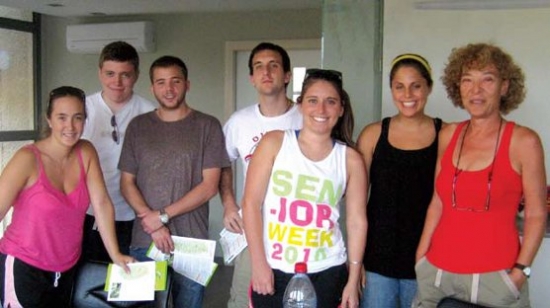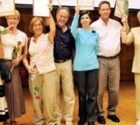
Ramona Bar-Lev (right) meeting with overseas students in the recently opened new offices of the Quatzrin municipality
One of the first settlers on the Golan Heights after the Six-Day War of 1967, Ramona Bar-Lev is a passionate and dedicated activist on behalf of the Golan residents.
Ramona readily admitted to a group of visiting students from Britain and North America that she didn’t leave her home town of Haifa in the 60s to stake a claim on the Golan because of political leanings – but because of her love for her Baghdad born husband Sammy Bar-Lev who later became one of the most prominent activists living on the Golan, and for many years, mayor of Qatzrin.
“You have no idea how desolate the Golan was. Why would I want to leave the comfort of the city – Haifa is a beautiful city – and live here?” she asked the students, but almost as if she is asking herself the same question.
“I moved here for love. I wanted to be with Sammy and he only wanted to live on the Golan. Nowadays I couldn’t think of living anywhere else. I love the Golan, the scenery, the quietness, walking my dogs through the gullies and over the hills. It is a very deep attachment that has expanded, grown immensely over the years. We belong here and we shall not be moved,” said Ramona one of the founder members of the Golan Residents Committee.
Nowadays, the committee is incorporated into the local Qatzrin municipality. As part of the Jewish population on the Golan comes under two other Israeli municipalities, the Qatzrin municipality contains a representative body of all rural Golan communities that include moshavim, kibbutzim and religious communities.
Originally Ramona and Sammy’s group moved into empty houses in Quneitra – a largely destroyed and abandoned Syrian city that was returned to the Syrians in 1974 but never rebuilt, and in present times is a sort of demilitarized zone between Israeli-held Golan and Syria. The United Nations have a strong presence in the area and the Syrians have built a new city with the same name a few kilometers away.
“When we arrived in Quneitra there were fifteen Syrian families still living there, two of them Christian families,” Ramona recalls. “We developed a relationship, not a close one but definitely one of correctness between people living in close proximity to each other.
The majority of the buildings in the town had been destroyed and it was a little eerie. Quneitra didn’t look like an attractive place to live by any means but the Circassian villages in the area were absolutely beautiful.”
In 1969 the settlers moved to the site of present-day Kibbutz Merom Golan at the foot of Mount Ben-Tal.
“Kibbutz didn’t appeal to me, didn’t suit my character or ambitions,” admitted the very individualistic Ramona, “and so we came to settle in Qatzrin.”
Ramona enthuses about the development of the town of 8,000 residents and refers to Qatzrin constantly as a city, emphasizes ancient Qatzrin and the fact that a short distance up the road from the municipality are the remains of a Jewish village from the Byzantine period, in the center of which is a large synagogue. Parts of the village and synagogue have been reconstructed.
Across the road from those remains stands the recently opened Ohelo Teachers Training College.
“A tender was put out by Ohelo when they decided to move from their old site on the shores of the Kinneret at Tzemach. There were many places that wanted the college, but we won the bidding,” exclaimed Ramona with great enthusiasm.
“Of Qatzrin’s 8,000 residents, some 30% are Russian immigrant families and there are also 120 families originally from South America. The rest of the population is Israeli born. There are very good relationships between the different groups and people on the whole have done well here, unemployment is below that of the national level and we are now working with Nefesh B’Nefesh to bring more immigrant families to the city.
“Many of the immigrants opened up small businesses here. Quite a few were artists and writers and one gentleman is a composer. They feel that the Golan is inspirational, enhancing their talents and motivation to make a living from their natural talents, and possibly they could not have done that had they lived in a different environment.”
Ramona also quashed the myth that living on the Golan was a golden tax break. “Unlike Kiryat Shmona and other areas of the Upper and Western Galilee we get no tax breaks whatsoever. The Golan Heights has enjoyed peace for over three decades, unlike those Galilee regions that suffered terrorist and rocket attacks from Lebanon. “Some former residents of Qatzrin moved to Kiryat Shmona because of the tax breaks but continue to commute to work here in this city,” she said with a wry smile.
Attracting local youth to return to Qatzrin after army service, travels and studies has been a struggle she admits, but hopes this will be rectified with the building of new houses to offer young families, and perhaps some of the graduates of the college – who hail from all over the country – will also fall in love with the Golan and want to stay when they have completed their studies.
Ramona’s two sons both live in Tel Aviv but she said that there are those who lived out of the area for a long period but have returned in recent years.
“The original pioneers of Qatzrin are now in their 60s and 70s so that being able to attract young people is of great importance for the future of the city as with any other - only here, maybe more,” she added wistfully.
Ramona dealt with the strategic importance of the Golan to Israel, water issues as well as that of the deep historical connection to the region, mentioning also the ancient and much revered site of Gamla. A bold headline stands out from literature on the table in front of her. Published in 2008 by The Golan Residents Committee, it reads:
‘Fact: Of 106 ancient synagogues in Israel – 32 are on the Golan.’
“The Golan has enjoyed peace now for over 30 years – it is the quietest border and we shall stay here in order that it remains that way. We are not going anywhere and as we struggled against notions in the past to return the Golan – including a 19 day hunger strike - we will continue to do so in the future. We shall not be moved.”
Heads buzzing with so much information and printed material to read at their leisure, the students thank Ramona for receiving them so warmly … and head back to their student dorms in the center of the country, but carrying the load of yet another complex topic to delve into further.
 AMIT DRESSLER - HELPING THE LESS FORTUNATE
AMIT DRESSLER - HELPING THE LESS FORTUNATE ESRA VOLUNTEER AWARD WINNERS 2010
ESRA VOLUNTEER AWARD WINNERS 2010 FACT OVERWHELMS FICTION
FACT OVERWHELMS FICTION A new website in English - on Volunteering - Launched in Israel
A new website in English - on Volunteering - Launched in Israel Help Needed for Abused Horses and Donkeys
Help Needed for Abused Horses and Donkeys Heather's Heseg
Heather's Heseg Lydia Aisenberg
Lydia Aisenberg